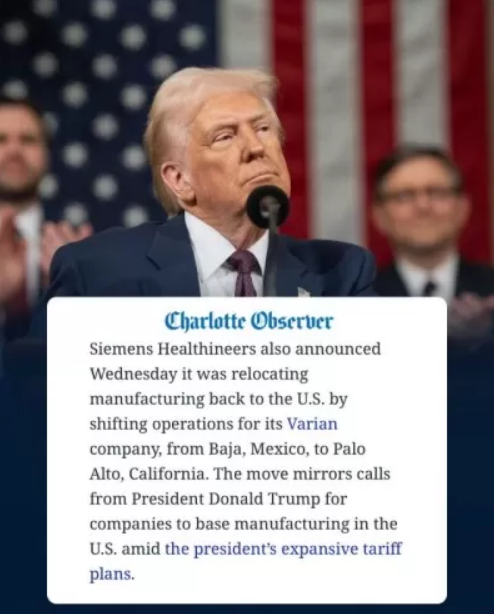Siemens Healthineers: Varian to Relocate Part of Production from Mexico to the United States
Siemens Healthineers has just announced plans to move part of Varian's manufacturing operations from Mexico to the United States.

The company plans to transfer Varian's manufacturing operations in Baja California, Mexico, to Palo Alto, California, which is expected to add about 50 manufacturing jobs.
Not only that, the company also plans to invest $150 million in new projects to expand production scale, create job opportunities, and better serve American customers.
01
Against the current backdrop, many healthcare technology companies are seeking to improve their domestic infrastructure in the U.S. to mitigate the impact of potential tariff policies that may be implemented by the Trump administration. Siemens Healthineers’ move is in line with this trend.
Siemens Healthineers' recent investment in the U.S. is built on its annual R&D spending of $900 million in the country. Since 2019, Siemens Healthineers has also invested $1 billion in the U.S. through facility expansions, acquisitions, and strategic partnerships.
In addition to migrating Varian's manufacturing operations, Siemens Healthineers also plans to enhance the resilience of its supply chain by opening two new large supply warehouses. These warehouses, located in Dayton, New Jersey, and Manteca, California, are expected to increase the availability of parts supply by nearly a third, thereby enhancing the flexibility of the supply chain. Additionally, the company plans to build a 60,000-square-foot experience center in Charlotte, North Carolina, to help healthcare providers achieve digital and healthcare transformation.
Siemens Healthineers expects that this business migration will streamline supply chain processes and enhance its ability to meet the demand for radiotherapy solutions.
John Kowal, President and Head of Siemens Healthineers Americas, said, "We have a large workforce and broad innovative portfolio in the U.S. and are making important contributions to the U.S. healthcare system. With this new investment, we are further demonstrating our long-term commitment and dedication to growing with the U.S. economy."
Recently, Jochen Schmitz, the Chief Financial Officer of Siemens Healthineers, stated that the current 10% basic tariff imposed by the U.S. accounts for over 50% of the company's tariff costs. The Trump administration's goal was to use tariffs as leverage to force companies to bring production jobs back to the U.S. in order to reduce their product costs.
Siemens Healthineers allocates its business in various countries roughly according to the regional sales volume. Therefore, the United States has about 30% of Siemens Healthineers' employees, Europe 40%, Asia 20%, and China 10%.
From the above personnel allocation, it is evident that the US market stands second only to Europe in importance. Bernd Montag, CEO of Siemens Healthineers, stated that the US market will account for approximately 36% of the company's revenue in 2024.
Bernd Montag said that the company can shift production, but only if it sees "economic justification."
That means we do have a strong business base in the US, and we believe we have the ability to adapt to any tariff environment going forward. But these kinds of decisions don’t get made overnight, and the situation is still fluid. For long-term investment like this, you need clarity. As for making adjustments to our production footprint to accommodate a bigger structural shift, it’s too early to say. But let me be clear: in the medium term, we’re confident that with our global manufacturing footprint, we can mitigate any potential impact from tariffs,” Montag said.
Bernd Montag's remarks reflect a certain level of uncertainty and a wait-and-see attitude among some businesses regarding the unpredictable environment created by the frequent policy changes of the Trump administration.
For example, recently, diagnostics giant Roche was betrayed.
In April, Roche announced that it will invest $50 billion in the United States over the next five years, creating more than 12,000 jobs, with a focus on the medical device sector.
On May 12, Roche announced plans to invest up to $550 million (nearly 4 billion RMB) to expand its continuous glucose monitoring (CGM) manufacturing center in the United States.
On that day, U.S. President Trump signed an executive order at a press conference in the White House aimed at significantly reducing domestic drug prices in the United States to align them with the lowest drug prices in the world. Trump anticipated that this move would lead to a substantial decrease in prescription drug and medication prices in the U.S., with reductions of up to 59% to 90%. He referred to this initiative as "one of the most influential executive orders in American history."

03
On May 7th, Siemens Healthineers released its second-quarter financial report. Despite the impact of tariffs, the financial results remained strong. However, Siemens Healthineers indicated that the impact of tariffs could significantly intensify in the coming months, and the company expects to invest between $227 million and $340 million in tariff mitigation measures.
Siemens Healthineers' revenue for the second quarter of 2025 reached $6.7 billion, a 25% increase compared to the second quarter of 2024. New orders grew strongly in the second quarter. The imaging business segment experienced the fastest growth, with an increase of nearly 9%; Varian's radiation therapy business segment saw a 13% growth in orders; advanced therapy business grew by 4%; and the diagnostics business is expected to achieve a 6.3% growth.
In the second quarter, revenue for the imaging business segment grew by 8.7% to nearly $3.7 billion. Particularly strong performance was seen in molecular imaging, where novel tracers used for theranostics drove volumes in the U.S. PETNET business as well as in the computed tomography (CT) business. The CT business also delivered strong results. At the 2024 Radiological Society of North America (RSNA), Siemens unveiled a new range of photon-counting CT systems at different price points, with orders set to begin in 2025.
From a regional perspective, the imaging business in the Americas has seen significant growth. The positive performance in North America is largely attributed to an 8-year, $600 million partnership agreement reached with Alberta, Canada. This agreement aims to enhance the province's capacity to provide medical services to an increasing number of patients by introducing new imaging and radiation therapy systems. Siemens stated that the agreement involves the sale of a large number of new imaging and treatment systems.
In addition, revenue in the Asia-Pacific region has seen slight growth. Meanwhile, due to ongoing delays in customer orders, revenue in China has experienced a slight decline. In the Europe, Middle East, and Africa region, revenue has decreased compared to the strong growth seen in the same period last year.
The company will closely monitor the fourth quarter, as it is typically the period with the most orders. At that time, the U.S. is expected to impose a higher tariff of 20% on goods from Europe, which will have the maximum impact on increasing volumes of import and export trade.
—
Trump's capriciousness has had a significant impact on the healthcare sector. His tariff policies have led to increased costs for medical supplies and equipment, disrupting supply chain stability andAt the same time, his "Most Favored Nation" drug pricing policy, although aimed at lowering drug prices, has faced significant challenges in implementation and has already sparked strong backlash from the pharmaceutical industry.
These policy uncertainties pose challenges for the healthcare industry, prompting companies to reassess their market positioning and strategies. They also accelerate the overseas expansion of medical products and domestic substitution in China, driving the reconfiguration of the global healthcare value chain.
【Copyright and Disclaimer】The above information is collected and organized by PlastMatch. The copyright belongs to the original author. This article is reprinted for the purpose of providing more information, and it does not imply that PlastMatch endorses the views expressed in the article or guarantees its accuracy. If there are any errors in the source attribution or if your legitimate rights have been infringed, please contact us, and we will promptly correct or remove the content. If other media, websites, or individuals use the aforementioned content, they must clearly indicate the original source and origin of the work and assume legal responsibility on their own.
Most Popular
-

At Least 44 Dead in Century-Old Fire! Questioning Hong Kong's Hong Fu Garden: Why Has the Path to Fire Resistance Taken 15 Years Without Progress?
-

Satellite chemical's profits surge! can the 26.6 billion yuan high-end new materials project meet expectations? a review of progress on four major projects
-

Key Players: The 10 Most Critical Publicly Listed Companies in Solid-State Battery Raw Materials
-

Estun Turns Profitable in 2025 Half-Year Report, Industrial Robot Shipments Rank First Among Domestic Brands
-

Avatr Files for IPO on HKEX, Plans to Complete Listing in Q2 2026






